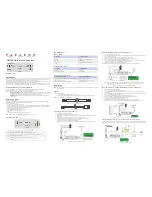
10.3.4. Incorrect state of charge reading
An incorrect state of charge can be caused by a variety of reasons.
Incorrect battery settings
The following parameter(s) will have an effect on the state of charge calculations if they have been set up incorrectly:
• Battery capacity.
Incorrect state of charge due to a synchronisation issue:
The state of charge is a calculated value and will need to be reset (synchronised) every now and then.
The synchronisation process is automatic and is performed each time the battery is fully charged. The battery monitor determines
that the battery is fully charged when all 3 "charged" conditions have been met. The "charged" conditions are:
• Charged voltage (Voltage).
• Tail current (% of battery capacity).
• Charge detection time (minutes).
A practical example of the conditions that need to be met before a synchronisation will take place:
• The battery voltage has to be above 13.8V.
• The charge current has to be less than 0.04 x battery capacity (Ah). For a 200Ah battery, this is 0.04 x 200 = 8A.
• Both above conditions have to be stable for 3 minutes.
If the battery is not fully charged or if the automatic synchronisation does not happen, the state of charge value will start to drift
and will eventually not represent the actual state of charge of the battery.
The following parameter(s) will have an effect on automatic synchronisation if they have been set incorrectly:
• Charged voltage.
• Tail current.
• Charged detection time.
• Not occasionally fully charging the battery.
For more information on these parameters see the chapter: "Battery settings".
Incorrect state of charge due to incorrect current reading:
The state of charge is calculated by looking at how much current flows in and out of the battery. If the current reading is incorrect,
the state of charge will also be incorrect. See paragraph
Incomplete current reading [37]
.
10.3.5. State of charge is missing
This means that the battery monitor is in an unsynchronised state. This can occur when the battery monitor has just been
installed or after it has been unpowered for some time and is being powered up again.
To fix this, fully charge the battery. Once the battery is close to a full charge, the battery monitor should synchronise automatically.
If that doesn't work, review the synchronisation settings.
If you know the battery is fully charged but don't want to wait until the battery synchronises, then perform a manual
synchronisation, see paragraph
.
10.3.6. State of charge does not reach 100%
The battery monitor will automatically synchronise and reset the state of charge to 100% as soon as the battery has been fully
charged. In case the battery monitor does not reach a 100% sate of charge, do the following:
• Fully charge the battery and check if the battery monitor correctly detects if the battery is fully charged.
• If the battery monitor does not detect that the battery has been fully charged you will need to check or adjust the charged
voltage, tail current and/or charged time settings. For more information see
Automatic synchronisation [16]
10.3.7. State of charge always shows 100%
One reason could be that the negative cables going in and out of the battery monitor have been wired the wrong way around, see
Charge and discharge current are inverted [37]
Manual - SmartShunt IP65
Page 38
Troubleshooting






































